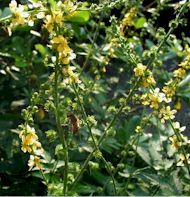 |
The Agrimony is a Simple well known to all country folk, and abundant throughout England in the fields and woods, as a popular domestic medicinal herb. It belongs to the Rose order of plants, and blossoms from June to September with small yellow flowers, which sit close along slender spikes a foot high, smelling like apricots, and called by the rustics "Church Steeples." Botanically it bears the names Agrimonia Eupatoria,
of which the first is derived from the Greek, and means "shining," because the herb is thought to cure cataract of the eye; and the second bears reference to the liver, as indicating the use of this plant for curing diseases of that organ. Chemists have determined that the Agrimony possesses a particular volatile oil, and |
yields nearly five per cent. of tannin, so that its use in the cottage for gargles, and as an astringent application to indolent wounds, is well justified. The herb does not seem really to own any qualities for acting medicinally on the liver. More probably the yellow color of its flowers, which, with the root, furnish a dye of a bright nankeen hue, has given it a reputation in bilious disorders, according to the doctrine of signatures,
because the bile is also yellow. Nevertheless, Gerard says: "A decoction of the leaves is good for them that have naughty livers." By pouring a pint of boiling water on a handful of the plant--stems, flowers and leaves an excellent gargle may be made for a relaxed throat; and a teacupful of the same infusion may be taken cold three or four times in the day for simple looseness of the bowels; also for passive losses of blood. In France,
Agrimony tea is drank as a beverage at table. This herb formed an ingredient of the genuine arquebusade water, as prepared against wounds inflicted by an arquebus, or hand-gun, and it was mentioned by Philip de Comines in his account of the battle of Morat, 1476. When the Yeomen of the Guard were first formed in England 1485 half were armed with bows and arrows, whilst the other half carried arquebuses. In France the eau de arquebusade
is still applied for sprains and bruises, being carefully made from many aromatic herbs. Agrimony was at one time included in the London Materia Medica as a vulnerary herb. It bears the title of Cocklebur, or Sticklewort, because its seed vessels cling by the hooked ends of their stiff hairs to any person or animal coming into contact with the plant. A strong decoction of the root and leaves, sweetened with honey, has been taken
successfully to cure scrofulous sores, being administered two or three times a day in doses of a wineglassful persistently for several months. Perhaps the special volatile oil of the plant, in common with that contained in other herbs similarly aromatic, is curatively antiseptic. Pliny called it a herb "of princely authorities."
The Hemp Agrimony, or St. John's Herb, belongs to the Composite order of plants, and grows on the margins of brooks, having hemp-like leaves, which are bitter of taste and pungent of smell, as if it were an umbelliferous herb. Because of these hempen leaves it was formerly called "Holy Rope," being thus named after the rope with which Jesus was bound. They contain a volatile oil, which acts on the kidneys; likewise some tannin, and a
bitter chemical principle, which will cut short the chill of intermittent fever, or perhaps prevent it. Provers of the plant have found it produce a "bilious fever," with severe headache, redness of the face, nausea, soreness over the liver, constipation, and high-colored urine. Acting on which experience, a tincture, prepared (H.) from the whole plant, may be confidently given in frequent small well-diluted doses with water for influenza,
or for a similar feverish chill, with break-bone pains, prostration, hot dry skin, and some bilious vomiting. Likewise a tea made with boiling water poured on the dried leaves will give prompt relief if taken hot at the onset of a bilious catarrh, or of influenza. This plant also is named Eupatorium because it refers, as Pliny says, to Eupator, a king of Pontus. In Holland it is used for jaundice, with swollen feet: and in America it
belongs to the tribe of bone-sets. The Hemp Agrimony grows with us in moist, shady places, with a tall reddish stem, and with terminal crowded heads of dull lilac flowers. Its distinctive title is Cannabinum, or "Hempen," whilst by some it is known as "Thoroughwort."
Herb Simples
The Primitive Simplers presented here show the way of life in other generations, it is not suggested or recommended trying them yourself. |


